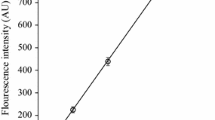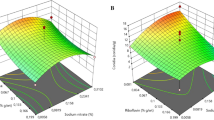Abstract
Bacillus thuringiensis is a spore-forming bacterium that produces delta-endotoxins, which are toxic to lepidopterans, dipterans and coleopterans. Concomitantly with production of delta-endotoxins, B. thuringiensis produces proteolytic enzymes during growth and sporulation, affecting yields of toxins production. In this work, an experimental factorial design was employed for the dual evaluation of effects of delta-endotoxins and proteolytic enzyme on activity of a B. thuringiensis subsp. kurstaki strain. Main effects and interactions of three factors (soybean meal, starch and aeration) under two conditions (0 and 7 g/l NaCl) were analysed using statistical techniques. Regression models, known as useful tool to build relationships between variables and subsequently to make predictions, were suggested to fit the experimental data. Yields ranged between 6.10–15.76 × 10−7 μg and 18.18–30.30 × 10−7 IU for delta-endotoxin and proteolytic enzymes per cell, respectively. When NaCl (7 g/l) was added to the medium, yields ranged from 15.51 to 38.06 for delta-endotoxins and from 9.56 to 48.73 for proteases. Starch, soybean meal and aeration improved the delta-endotoxins production. Interactions (starch × air) and (soybean meal × air) showed a negative effect on delta-endotoxin yield, while (starch × soybean meal) had no effect. The active function of aeration was enhanced when NaCl (7 g/l) was added, and effects of all interactions on delta-endotoxins yield had been nullified. Soybean meal and aeration had negative effects on proteolytic activity, in contrast to starch, (starch × air) and (soybean × air), which improved proteolytic activity yields. The inhibitory role of soybean meal shifted to positive effect according to the presence of NaCl (7 g/l) in the culture medium.
Similar content being viewed by others
References
Asano, S.I.; Yamashita, C.; Lizuka, T.; Takeuchi, K.; Yamanaka, S.; Cerf, D.; Yamamoto, T.: A strain Bacillus thuringiensis subsp. galleriae containing a novel cry8 gene highly toxic to Anomala cuprea (Coleoptera: Scarabaeidae). Biol. Control. (2003). doi:10.1016/S1049-9644(03)00060-4
Ennouri, K.; Ben Khedher, S.; Jaoua, S.; Zouari, N.: Correlation between delta-endotoxin and proteolytic activities produced by Bacillus thuringiensis var. kurstaki growing in an economic production medium. Biocontrol Sci. Technol. (2013). doi:10.1080/09583157.2013.791364
Sela, S.; Schickler, H.; Chet, I.; Spiegel, Y.: Purification and characterization of Bacillus cereus collagenolytic/proteolytic enzyme and its effect on Meloidogyne javanica cuticular proteins. Eur. J. Plant Pathol. (1988). doi:10.1023/A:1008643414691
Ennouri K., Ben Hassen H., Ben Khedher S., Zouari N.: Concomitant production of delta-endotoxins and proteases of Bacillus thuringiensis subsp. kurstaki in a low-cost medium: effect of medium components. Acta Biol. Szeged. 57, 13–19 (2013)
Puri, S.; Beg, Q.K.; Gupta, R.: Optimization of alkaline protease production from Bacillus sp. by response surface methodology. Curr. Microbiol. (2002). doi:10.1007/s00284-001-0006-8
Reddy, L.V.A.; Wee, Y.J.; Yun, J.S.; Ruy, H.W.: Optimization of alkaline protease production by batch culture of Bacillus sp. RKY3 through Plackett–Burman and response surface methodological approaches. Bioresour. Technol. (2008). doi:10.1016/j.biortech.2007.05.006
Sevinc N., Demirkan E.: Production of Protease by Bacillus sp. N-40 isolated from soil and its enzymatic properties. J. Biol. Environ. Sci. 5, 95–103 (2011)
Castro, M.T.; Baccan, N.: Application of factorial design in optimization of preconcentration procedure for copper determination in soft drink by flame atomic absorption spectrometry. Talanta. (2005). doi:10.1016/j.talanta.2004.09.002
Keppel G., Wickens T.D.: Design and Analysis. Pearson, Prentice Hall (2004)
Dulmage H.T.: Insecticidal activity of HD-1, a new isolate of Bacillus thuringiensis var. Alesti. J. Invert. Pathol. 15, 232–239 (1970)
Dulmage H.T., Boeninig O.P., Rehnborg C.S., Hansen G.D.: A proposed standardized bioassay for formulation of Bacillus thuringiensis based on the international unit. J. Invert. Pathol. 18, 240–245 (1971)
Ghribi, D.; Zouari, N.; Trigui, W.; Jaoua, S.: Use of sea water as salts source in starch and soya bean based media for production of Bacillus thuringiensis bioinsecticides. Process Biochem. (2007). doi:10.1016/j.procbio.2006.09.006
Zouari, N.; Dhouib, A.; Ellouz, R.; Jaoua, S.: Nutritional requirements of a Bacillus thuringiensis subsp kurstaki strain and use of gruel hydrolysate for the formulation of a new medium for delta-endotoxin production. Appl. Biochem. Biotechnol. (1998). doi:10.1007/BF02786020
Bradford, M.: A rapid and sensitive method for the quantitation of microgram quantities of protein utilizing the principle of protein-dye binding. Anal. Biochem. (1976). doi:10.1016/0003-2697(76)90527-3
Kunitz, M.: Crystalline soybean trypsin inhibitor: II general proprieties. J. Gen. Physiol. (1947). doi:10.1085/jgp.30.4.291
Lachhab, K.: Production of Bacillus thuringiensis biopesticides using wastewater sludge as a raw material: effect of inoculum and sludge solids. Process Biochem. (2001). doi:10.1016/S0032-9592(01)00198-4
Ben Khedher S., Jaoua S., Zouari N.: Application of statistical experimental design for optimisation of bioinsecticides production by sporeless Bacillus thuringiensis strain on cheap medium. Braz. J. Microbiol. 44, 927–933 (2013)
Ben Khedher, S.; Jaoua, S.; Zouari, N.: Overcome of carbon catabolite repression of bioinsecticides production by sporeless Bacillus thuringiensis through adequate fermentation technology. Biotechnol. Res. Int. (2014). doi:10.1155/2014/698587
Ennouri K., Ben Hassen H., Zouari N.: Optimization of bioinsecticides overproduction by Bacillus thuringiensis subp. kurstaki using linear regression. Pol. J. Microbiol. 62, 287–293 (2013)
Tajber, L.; Corrigan, O.I.; Healy, A.M.: Spray drying of budesonide, formoterol fumarate and their composites—II. Statistical factorial design and in vitro deposition properties. Int. J. Pharm. (2009). doi:10.1016/j.ijpharm.2008.09.029
Pearson, D.; Ward, O.P.: Effect of culture conditions on growth and sporulation of Bacillus thuringiensis subsp. israelensis and development of media for production of protein crystal endotoxin. Biotechnol. Lett. (1988). doi:10.1007/BF01027055
Sachdeva, V.; Tyagi, R.D.; Valero, J.R.: Factors affecting the production of Bacillus thuringiensis biopesticides. In: Pandalai, S.G. (ed.) Recent Research Developments in Microbiology, pp. 363–375. Research Signpost Press, Trivandrum, India (1999)
Nascimento W., Martins M.: Production and properties of an extracellular protease from thermophilic Bacillus sp. Braz. J. Microbiol. 35, 91–96 (2004)
Myers R.H., Montgomery R.C., Anderson-Cook C.M.: Response Surface Methodology: Process and Product Optimization Using Designed Experiments. Wiley, New York (2009)
Foda, M.S.; Salama, H.S.; Selim, M.: Factors affecting the growth physiology of Bacillus thuringiensis. Appl. Microbiol. Biotechnol. (1985). doi:10.1007/BF00252156
Morris, O.N.; Converse, P.; Kanagaratnam, P.; Davies, J.S.: Effect of cultural conditions on spore-crystal yield and toxicity of Bacillus thuringiensis subsp. aizawai HD133. J. Invertebr. Pathol. (1996). doi:10.1006/jipa.1996.0020
Rudolph, A.; Crowe, J.; Cowe, L.: Effects of three stabilizing agents—proline, betaine and trehalose—on the membrane phospholipids. Arch. Biochem. Biophys. (1986). doi:10.1016/0003-9861(86)90197-9
Beg, Q.K.; Gupta, R.: Purification and characterization of an oxidation-stable, thiol-dependent serine alkaline protease from Bacillus mojavensis. Enz. Microb. Technol. (2003). doi:10.1016/S0141-0229(02)00293-4
Maal K.B., Emtiazi G., Nahvi I.: Production of alkaline protease by Bacillus cereus and Bacillus polymixa in a new industrial culture medium and its immobilization. Afr. J. Microbiol. Res. 3, 491–497 (2009)
Mahmoud A.U., Greenman J., Scragg A.H.: Effects of macromolecular growth substrates on production of extracellular enzymes by Bacillus sp. in continuous culture. Microbios 103, 85–96 (2000)
Kaur, S.: Molecular approaches towards development of novel Bacillus thuringiensis biopesticides. World J. Microbiol. Biotechnol. (2000). doi:10.1023/A:1008931207374
Tan, Y.; Donovan, W.P.: Deletion of aprA and nprA genes for alkaline protease A and neutral protease A from Bacillus thuringiensis: effect on insecticidal crystal proteins. J. Biotechnol. (2000). doi:10.1016/S0168-1656(00)00328-X
Frankena, J.; Koningstein, G.M.; Verseveld, H.W.; Stouthamer, A.H.: Effect of different limitations in chemostat cultures on growth and production of exocellular protease by Bacillus licheniformis. Appl. Microbiol. Biotechnol. (1986). doi:10.1007/BF00938779
Author information
Authors and Affiliations
Corresponding author
Rights and permissions
About this article
Cite this article
Ennouri, K., Ben Hassen, H. & Zouari, N. Statistical Analysis of Cultural Parameters Influencing Delta-Endotoxins and Proteases Productions by Bacillus thuringiensis kurstaki . Arab J Sci Eng 41, 1–8 (2016). https://doi.org/10.1007/s13369-015-1722-x
Received:
Accepted:
Published:
Issue Date:
DOI: https://doi.org/10.1007/s13369-015-1722-x




